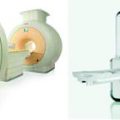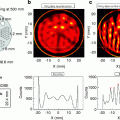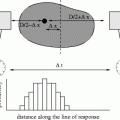Fig. 12.1
Properties (resolution and sensitivity) of various medical imaging methods
Although noise is a problem in all medical imaging applications, it is prominent in medical imaging using ionizing radiation due to the fact that from the physics point of view, lower noise can only be achieved by higher doses due to X-rays or radioisotopes, which would result in higher exposures of the patient. Since the amount of applied radioactive material to a human being has to be limited as much as possible, the noise problem is very prominent in nuclear medical applications.
The goal of optimizing the nuclear medical imaging technologies and methods is to provide better diagnostic performance which means a better or more secure performance, which would in the best case result in a possible earlier diagnosis of a disease or even a complete new diagnosis. As a crude approximation, the clinical performance (CP) can be described by the following equation:
 where HOP means the human observer performance which is obviously only somehow correlated to the image quality, DQEPres is the detective quantum efficiency of the presentation procedure, DQEDetect is the detective quantum efficiency of the detection process and NEQGen is the noise equivalent quanta of the signal generation. The latter is influenced by the biokinetics, the dose modeling for each patient, and the time scheme of the imaging process. DQEDetect depends on the detector efficiency, the spatial resolution properties, and the calibration facilities, while the presentation DQE mainly reflects the efficiency of the reconstruction and image processing procedures.
where HOP means the human observer performance which is obviously only somehow correlated to the image quality, DQEPres is the detective quantum efficiency of the presentation procedure, DQEDetect is the detective quantum efficiency of the detection process and NEQGen is the noise equivalent quanta of the signal generation. The latter is influenced by the biokinetics, the dose modeling for each patient, and the time scheme of the imaging process. DQEDetect depends on the detector efficiency, the spatial resolution properties, and the calibration facilities, while the presentation DQE mainly reflects the efficiency of the reconstruction and image processing procedures.

This goal of optimizing the nuclear medical imaging performance in terms of an optimized tool for diagnosis must be correlated with the general principle of optimization of radiation protection of keeping doses “as low as reasonable achievable” [1] as it is valid according to legal requirements for the use of ionizing radiation especially in the context of medical applications.
In respect of this, optimization needs contributions from multiple disciplines:
1.
Clinicians providing clear clinical tasks and make a clear indication case
2.
Physicians, biologists, and chemists developing sensitive and specific new biomarkers
3.
Physicians and biophysicists investigating bio- and pharmacokinetics
4.
Medical physicists and engineers providing tools for optimized spatial and or temporal resolution, taking physical and practical limitations into account
5.
Mathematicians and software developers contributing algorithms and software packages specifically designed for the development
In the following, the above aspects will be briefly described in its connection with the purpose of optimization and the other components of this optimization process.
12.1 Clinicians Providing Clear Clinical Tasks and Make a Clear Indication Case
As a part of the ALARA principle, it is necessary to avoid all kinds of exposures to human beings which are not justified, e.g., by medical needs. In this regard it is really necessary to identify and describe the intended benefit for the patient and balance it versus the estimated doses and the corresponding risks. For further aspects of this, we refer to the rules of the thumb chapter in the second book of this series [2]. The description of the clinical task has further aspects in the optimization procedure. First of all, depending on the task, the ideal imaging system might be different. In connection with this, the optimal radiopharmaceutical and the optimal dosage have to be determined. This refers to actual available radiopharmaceuticals and data but could be changing according to the optimization processes described in the following. The last aspect about the optimization regarding the description of the clinical task is the choosing of the optimal time point for the investigation. This will depend on the accumulation of the radiopharmaceutical within the lesion of interest compared to the background.
12.2 Physicians, Biologists, and Chemists Developing New Sensitive and Specific New Biomarkers
As indicated already before, optimal biomarkers are needed able to bind to the diseased cells in question (sensitivity) or characterize the activity of a tissue. It should be avoided that the biomarkers also bind to cells characterizing normal tissues and therefore not being specific markers for the pathology. Not all radiopharmaceuticals available today fulfill these conditions. This lack of specificity and/or sensitivity might result in higher exposures necessary to gain a diagnostic image useful for clinical diagnosis. The importance of an optimal sensitivity and specificity as well as the signal-to-noise ratio depends also on the clinical task in question.
Stay updated, free articles. Join our Telegram channel

Full access? Get Clinical Tree






